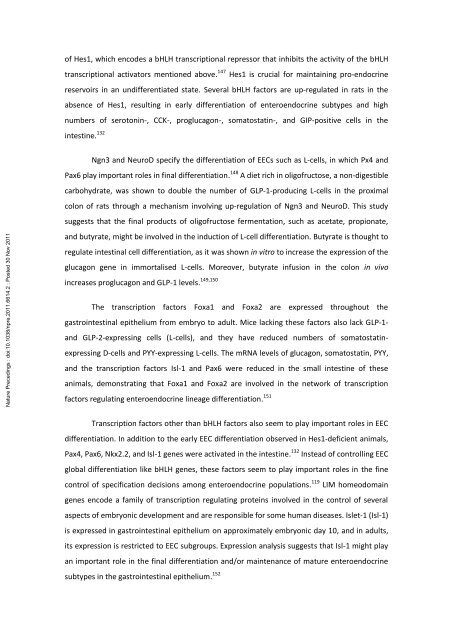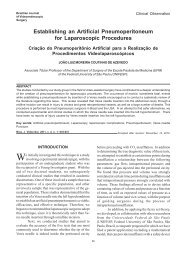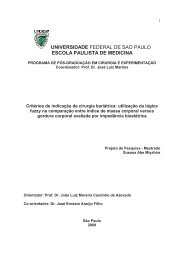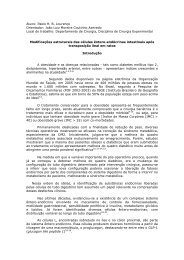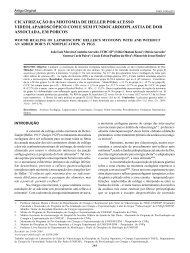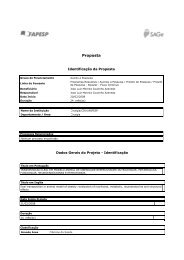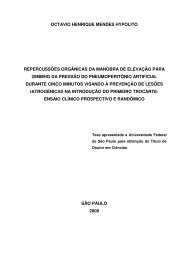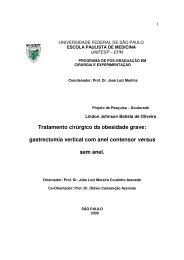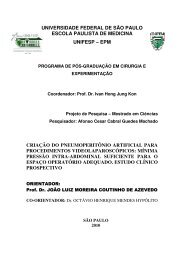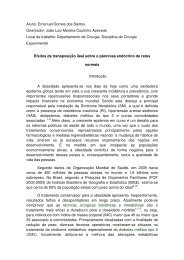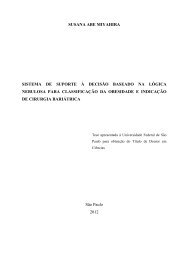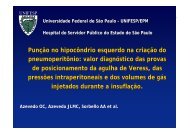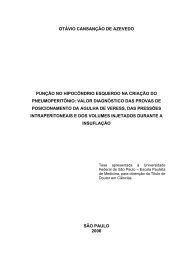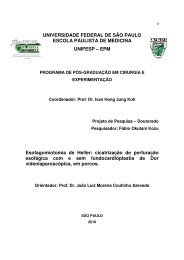Isolated ileal interposition in enteroendocrine L cells differentiation
Isolated ileal interposition in enteroendocrine L cells differentiation
Isolated ileal interposition in enteroendocrine L cells differentiation
You also want an ePaper? Increase the reach of your titles
YUMPU automatically turns print PDFs into web optimized ePapers that Google loves.
of Hes1, which encodes a bHLH transcriptional repressor that <strong>in</strong>hibits the activity of the bHLH<br />
transcriptional activators mentioned above. 147 Hes1 is crucial for ma<strong>in</strong>ta<strong>in</strong><strong>in</strong>g pro-endocr<strong>in</strong>e<br />
reservoirs <strong>in</strong> an undifferentiated state. Several bHLH factors are up-regulated <strong>in</strong> rats <strong>in</strong> the<br />
absence of Hes1, result<strong>in</strong>g <strong>in</strong> early <strong>differentiation</strong> of enteroendocr<strong>in</strong>e subtypes and high<br />
numbers of seroton<strong>in</strong>-, CCK-, proglucagon-, somatostat<strong>in</strong>-, and GIP-positive <strong>cells</strong> <strong>in</strong> the<br />
<strong>in</strong>test<strong>in</strong>e. 132<br />
Ngn3 and NeuroD specify the <strong>differentiation</strong> of EECs such as L-<strong>cells</strong>, <strong>in</strong> which Px4 and<br />
Pax6 play important roles <strong>in</strong> f<strong>in</strong>al <strong>differentiation</strong>. 148 A diet rich <strong>in</strong> oligofructose, a non-digestible<br />
carbohydrate, was shown to double the number of GLP-1-produc<strong>in</strong>g L-<strong>cells</strong> <strong>in</strong> the proximal<br />
Nature Preced<strong>in</strong>gs : doi:10.1038/npre.2011.6614.2 : Posted 30 Nov 2011<br />
colon of rats through a mechanism <strong>in</strong>volv<strong>in</strong>g up-regulation of Ngn3 and NeuroD. This study<br />
suggests that the f<strong>in</strong>al products of oligofructose fermentation, such as acetate, propionate,<br />
and butyrate, might be <strong>in</strong>volved <strong>in</strong> the <strong>in</strong>duction of L-cell <strong>differentiation</strong>. Butyrate is thought to<br />
regulate <strong>in</strong>test<strong>in</strong>al cell <strong>differentiation</strong>, as it was shown <strong>in</strong> vitro to <strong>in</strong>crease the expression of the<br />
glucagon gene <strong>in</strong> immortalised L-<strong>cells</strong>. Moreover, butyrate <strong>in</strong>fusion <strong>in</strong> the colon <strong>in</strong> vivo<br />
<strong>in</strong>creases proglucagon and GLP-1 levels. 149,150<br />
The transcription factors Foxa1 and Foxa2 are expressed throughout the<br />
gastro<strong>in</strong>test<strong>in</strong>al epithelium from embryo to adult. Mice lack<strong>in</strong>g these factors also lack GLP-1-<br />
and GLP-2-express<strong>in</strong>g <strong>cells</strong> (L-<strong>cells</strong>), and they have reduced numbers of somatostat<strong>in</strong>express<strong>in</strong>g<br />
D-<strong>cells</strong> and PYY-express<strong>in</strong>g L-<strong>cells</strong>. The mRNA levels of glucagon, somatostat<strong>in</strong>, PYY,<br />
and the transcription factors Isl-1 and Pax6 were reduced <strong>in</strong> the small <strong>in</strong>test<strong>in</strong>e of these<br />
animals, demonstrat<strong>in</strong>g that Foxa1 and Foxa2 are <strong>in</strong>volved <strong>in</strong> the network of transcription<br />
factors regulat<strong>in</strong>g enteroendocr<strong>in</strong>e l<strong>in</strong>eage <strong>differentiation</strong>. 151<br />
Transcription factors other than bHLH factors also seem to play important roles <strong>in</strong> EEC<br />
<strong>differentiation</strong>. In addition to the early EEC <strong>differentiation</strong> observed <strong>in</strong> Hes1-deficient animals,<br />
Pax4, Pax6, Nkx2.2, and Isl-1 genes were activated <strong>in</strong> the <strong>in</strong>test<strong>in</strong>e. 132 Instead of controll<strong>in</strong>g EEC<br />
global <strong>differentiation</strong> like bHLH genes, these factors seem to play important roles <strong>in</strong> the f<strong>in</strong>e<br />
control of specification decisions among enteroendocr<strong>in</strong>e populations. 119 LIM homeodoma<strong>in</strong><br />
genes encode a family of transcription regulat<strong>in</strong>g prote<strong>in</strong>s <strong>in</strong>volved <strong>in</strong> the control of several<br />
aspects of embryonic development and are responsible for some human diseases. Islet-1 (Isl-1)<br />
is expressed <strong>in</strong> gastro<strong>in</strong>test<strong>in</strong>al epithelium on approximately embryonic day 10, and <strong>in</strong> adults,<br />
its expression is restricted to EEC subgroups. Expression analysis suggests that Isl-1 might play<br />
an important role <strong>in</strong> the f<strong>in</strong>al <strong>differentiation</strong> and/or ma<strong>in</strong>tenance of mature enteroendocr<strong>in</strong>e<br />
subtypes <strong>in</strong> the gastro<strong>in</strong>test<strong>in</strong>al epithelium. 152


